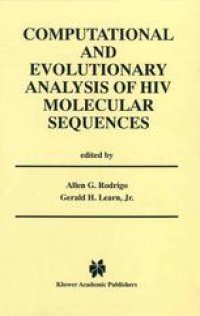
Ebook: Computational and Evolutionary Analysis of HIV Molecular Sequences
- Tags: Internal Medicine, Data Structures Cryptology and Information Theory, Animal Anatomy / Morphology / Histology, Pharmacology/Toxicology, Evolutionary Biology
- Year: 2002
- Publisher: Springer US
- Edition: 1
- Language: English
- pdf
Computational and Evolutionary Analysis of HIV Molecular Sequences is for all researchers interested in HIV research, even those who only have a nodding acquaintance with computational biology (or those who are familiar with some, but not all, aspects of the field). HIV research is unusual in that it brings together scientists from a wide range of disciplines: clinicians, pathologists, immunologists, epidemiologists, virologists, computational biologists, structural biologists, evolutionary biologists, statisticians and mathematicians. This book seeks to bridge the gap between these groups, in both subject matter and terminology. Focused largely on HIV genetic variation, Computational and Evolutionary Analysis of HIV MolecularSequences covers such issues as sampling and processing sequences, population genetics, phylogenetics and drug targets.
Computational and Evolutionary Analysis of HIV Molecular Sequences is for all researchers interested in HIV research, even those who only have a nodding acquaintance with computational biology (or those who are familiar with some, but not all, aspects of the field). HIV research is unusual in that it brings together scientists from a wide range of disciplines: clinicians, pathologists, immunologists, epidemiologists, virologists, computational biologists, structural biologists, evolutionary biologists, statisticians and mathematicians. This book seeks to bridge the gap between these groups, in both subject matter and terminology. Focused largely on HIV genetic variation, Computational and Evolutionary Analysis of HIV MolecularSequences covers such issues as sampling and processing sequences, population genetics, phylogenetics and drug targets.
Computational and Evolutionary Analysis of HIV Molecular Sequences is for all researchers interested in HIV research, even those who only have a nodding acquaintance with computational biology (or those who are familiar with some, but not all, aspects of the field). HIV research is unusual in that it brings together scientists from a wide range of disciplines: clinicians, pathologists, immunologists, epidemiologists, virologists, computational biologists, structural biologists, evolutionary biologists, statisticians and mathematicians. This book seeks to bridge the gap between these groups, in both subject matter and terminology. Focused largely on HIV genetic variation, Computational and Evolutionary Analysis of HIV MolecularSequences covers such issues as sampling and processing sequences, population genetics, phylogenetics and drug targets.
Content:
Front Matter....Pages i-viii
Sampling and Processing HIV Molecular Sequences: A Computational Evolutionary Biologist’s Perspective....Pages 1-17
Accessing HIV Molecular Information....Pages 19-26
HIV-1 Subtyping....Pages 27-53
HIV Sequence Sigmatires and Similarities....Pages 55-72
Graphical Methods for Exploring Sequence Relationships....Pages 73-90
Quantifying Heterogeneity in the HIV Genome....Pages 91-119
Phylogenetics of HIV....Pages 121-160
Goals and Strategies for Analysis of Recombination among HIV Molecular Sequences....Pages 161-171
Molecular Population Genetics: Coalescent Methods Based on Summary Statistics....Pages 173-216
Population Geetics of HIV: Parameter Estimation Using Genealogy-based Methods....Pages 217-252
Detecting Selection in Protein Coding Genes Using the Rate of Nonsynonymous and Synonymous Divergence....Pages 253-267
Drugs Targeted at HIV — Successes and Resistance....Pages 269-286
Back Matter....Pages 287-300
Computational and Evolutionary Analysis of HIV Molecular Sequences is for all researchers interested in HIV research, even those who only have a nodding acquaintance with computational biology (or those who are familiar with some, but not all, aspects of the field). HIV research is unusual in that it brings together scientists from a wide range of disciplines: clinicians, pathologists, immunologists, epidemiologists, virologists, computational biologists, structural biologists, evolutionary biologists, statisticians and mathematicians. This book seeks to bridge the gap between these groups, in both subject matter and terminology. Focused largely on HIV genetic variation, Computational and Evolutionary Analysis of HIV MolecularSequences covers such issues as sampling and processing sequences, population genetics, phylogenetics and drug targets.
Content:
Front Matter....Pages i-viii
Sampling and Processing HIV Molecular Sequences: A Computational Evolutionary Biologist’s Perspective....Pages 1-17
Accessing HIV Molecular Information....Pages 19-26
HIV-1 Subtyping....Pages 27-53
HIV Sequence Sigmatires and Similarities....Pages 55-72
Graphical Methods for Exploring Sequence Relationships....Pages 73-90
Quantifying Heterogeneity in the HIV Genome....Pages 91-119
Phylogenetics of HIV....Pages 121-160
Goals and Strategies for Analysis of Recombination among HIV Molecular Sequences....Pages 161-171
Molecular Population Genetics: Coalescent Methods Based on Summary Statistics....Pages 173-216
Population Geetics of HIV: Parameter Estimation Using Genealogy-based Methods....Pages 217-252
Detecting Selection in Protein Coding Genes Using the Rate of Nonsynonymous and Synonymous Divergence....Pages 253-267
Drugs Targeted at HIV — Successes and Resistance....Pages 269-286
Back Matter....Pages 287-300
....